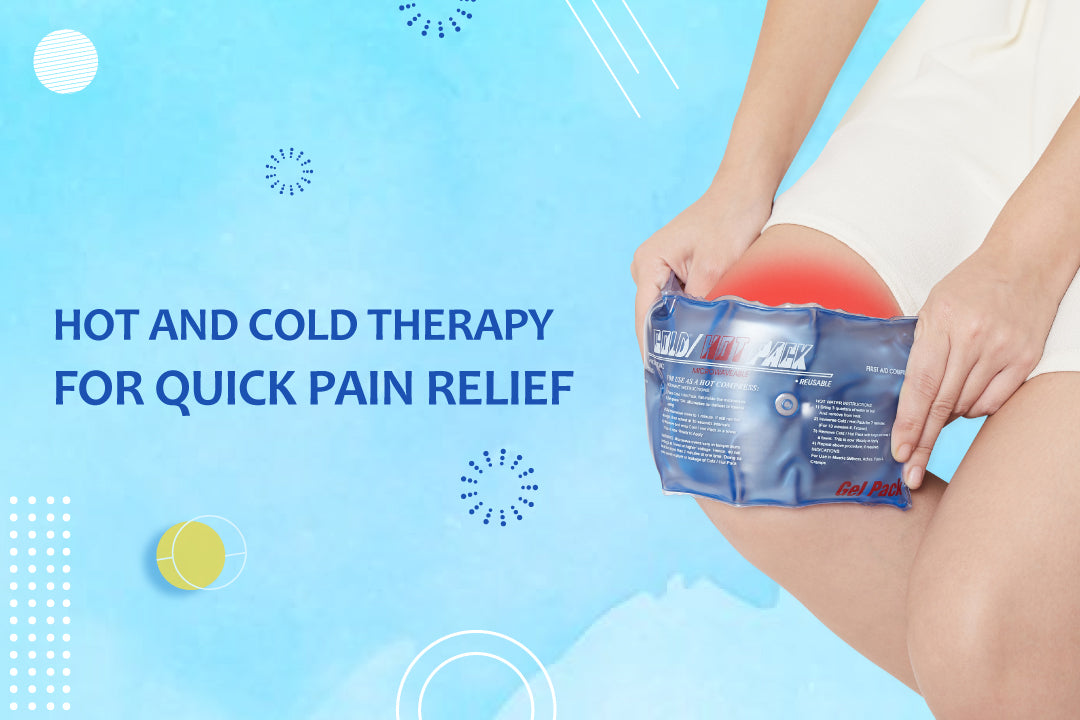Hot & Cold Therapy For Quick Pain Relief

Hot & Cold Therapy For Quick Pain Relief
We all know that treating pain with the hot and cold method has been used since ancient times. Whether you experience inflammation or pulled muscle, applying the accurate hot or cold therapy becomes the need of the hour. Sometimes, however, it becomes tricky to know which therapy is appropriate for a particular situation, and at times it is also seen that a single problem calls for both hot and cold compressions to be used alternatively. Usually, the thumb rule followed is ice/cold therapy for acute injuries and pain, and hot compressions for stiffness or muscle pain.
Heat Therapy
Heat Therapy increases the blood flow of the affected area and soothes down the discomfort, thereby, increasing muscle flexibility. Using heat therapy helps in relaxing damaged tissues and heals them eventually. It is most effective at the time of morning stiffness, strain or sprain, swelling, slow blood flow, etc.
Types of Heat Therapy
Heat therapy is classified into two: Moist Heat and Dry Heat. The basic prerequisite for both therapies is that the temperature must be ideal and not very hot.
Moist Heat: Also called Convection Heat, includes treatments like hot baths, steamed towels or any other cloth, moist heating pads, etc. The application time for this therapy is less and is slightly more effective than the dry heat therapy.
Dry Heat: Also called Conducted Heat therapy, includes treatments like dry heating pads, saunas, dry heating packs, etc. The therapy is easy and helps in reducing the stiffness of muscles.
You can also go for professional heat therapy sessions such as ultrasound which is beneficial to heal the pain in tendonitis.
While going for heat therapy, you can choose between local, regional, and complete body treatment. The Local Therapy is for minor injuries like stiffness and can be healed using a hot water bottle or gel pack. Regional Therapy can be used for the overall stiffness or pain and can be healed using heat wraps, steamed towels, or large heating pads. The full-body treatment includes hot baths or saunas.
Heat Therapy: When Not To Use?
Though heat therapy is beneficial, there are some cases when you should not use the same. You should never apply heat therapy on open wounds or bruised areas as it can increase complications. Pre-existing conditions such as burns can develop further complexities with heat therapies. Other conditions such as dermatitis, diabetes, multiple sclerosis, vascular diseases, and deep vein thrombosis should not be treated with heat therapy. If you are suffering from hypertension or if you are pregnant, you must consider consulting your doctor before choosing heat therapies including saunas and hot baths.
How to Apply Heat Therapy
Heat therapy is only beneficial if you take a reasonable amount of time to apply it. If there is only minor stiffness, you can use it for 15-20 minutes, and for moderate stiffness or pain, heat should be applied for anywhere between 30 minutes to two hours.
Cold therapy or Cryotherapy works by decreasing the blood flow of the injured area and reducing the pain or inflammation around the joint or a tendon. Cold therapy relieves the pain by reducing nerve activity and making the area numb.
Types of Cold Therapy
Cold therapy can be applied in different ways, and the treatment options include ice packs or gel packs, coolant spray, ice baths, and ice massage.
Some other types of Cold Therapy treatments include:
Cryo Stretching is used for reducing the muscle spasm which is caused during stretching.
Cryokinetics is a combination of cold therapy treatment and exercises and is beneficial for ligament sprain.
Cold Therapy: When Not To Use?
People suffering from sensory disorders should prevent using cold therapy as the senses are hampered and usage of cold therapy can weaken them further. The situation includes diabetes, which results in the damaging of nerves and makes them less sensitive. It is appropriate not to use cold therapy on stiff joints or muscles as it can cause poor blood circulation and increase complexities.
How to Apply Cold Therapy
For applying cold therapy at home, you can use an ice pack to the affected area. You should never apply the frozen pack directly on the skin, but wrap it in a towel, as the direct application can cause skin and tissue damage. For better results, cold therapy must be used at least 4-5 times a day for 15-20 minutes.
It is imperative to know when to use cold or hot therapy. Sometimes, both hot and cold therapy is helpful for a particular condition. For example, if we talk about arthritis, you can use cold therapy for swelling, whereas, for stiffness of joints, you can use heat therapy.
Both the therapies have their potential risks, therefore, use them cautiously after the approval of your doctor. To know more, Click Here.

